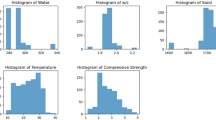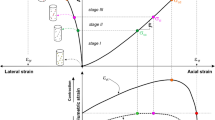Abstract
Predicting the penetration rate of a tunnel boring machine (TBM) plays an important role in the economic and time planning of tunneling projects. In the past years, various empirical methods have been developed for the prediction of TBM penetration rates using traditional statistical analysis techniques. Soft computing techniques are now being used as an alternative statistical tool. In this study, a fuzzy logic model was developed to predict the penetration rate based on collected data from one hard rock TBM tunnel (the Queens Water Tunnel # 3, Stage 2) in New York City, USA. The model predicts the penetration rate of the TBM using rock properties such as uniaxial compressive strength, rock brittleness, distance between planes of weakness and the orientation of discontinuities in the rock mass. The results indicated that the fuzzy model can be used as a reliable predictor of TBM penetration rate for the studied tunneling project. The determination coefficient (R 2), the variance account for and the root mean square error indices of the proposed fuzzy model are 0.8930, 89.06 and 0.13, respectively.










Similar content being viewed by others
References
Acaroglu O (2011) Prediction of thrust and torque requirements of TBMs with fuzzy logic models. Tunn Undergr Space Technol 26:267–275
Acaroglu O, Ozdemir L, Asbury B (2008) A fuzzy logic model to predict specific energy requirement for TBM performance prediction. Tunn Undergr Space Technol 23:600–608
Alber M (1996) Prediction of penetration, utilization for hard rock TBMs. In: Proceedings of the international conference of Eurock ‘96, Balkema, Rotterdam, pp 721–725
Alber M (2000) Advance rates of hard rock TBMs and their effects on project economics. Tunn Undergr Space Technol 15:55–64
Ataei M, Khalokakaei R, Hossieni M (2009) Determination of coal mine mechanization using fuzzy logic. Min Sci Technol 19:149–154
Aydin A (2004) Fuzzy set approaches to classification of rock masses. Eng Geol 74:227–245
Azimi Y, Osanloo M, Aakbarpour-Shirazi M, Aghajani Bazzazi A (2010) Prediction of the blastability designation of rock masses using fuzzy sets. Int J Rock Mech Min Sci 47:1126–1140
Bamford WF (1984) Rock test indices are being successfully correlated with tunnel boring machine performance. In: Proceedings 5th Australian tunneling conference, Melbourne, vol 2, pp 9–22
Barton N (1999) TBM performance estimation in rock using Qtbm. Tunn Tunn Int 31:41–48
Benardos AG, Kaliampakos DC (2004) Modelling TBM performance with artificial networks. Tunn Undergr Space Technol 19:597–605
Bieniawski ZT, Tamames BC, Fernandez JMG, Hernandez MA (2006) Rock mass excavability (RME) indicator: new way to selecting the optimum tunnel construction method. ITA-AITES World Tunnel Congress & 32nd ITA General Assembly, Seoul, Korea
Blindheim OT (1979) Boreabilty predictions for tunneling. PhD Thesis. Department of geological engineering. The Norwegian Institute of Technology, Trondheim, Norway
Bruland A (1999) Hard rock tunnel boring: advance rate and cutter wear. The Norwegian Institute of Technology, Trondheim, Norway
Cassinelli F, Cina S, Innaurato N, Mancini R, Sampaolo A (1982) Power consumption and metal wear in tunnel-boring machines: analysis of tunnel boring machine operation in hard rock. In: Proceedings Tunneling’82, London, Inst Min Metall, pp 73–81
Deb D (2003) Analysis of coal mine roof fall rate using fuzzy reasoning techniques. Int J Rock Mech Min Sci 40:251–257
Dodagoudar GR, Venkatachalam G (2000) Reliability analysis of slopes using fuzzy sets theory. Comput Geotech 27:101–115
Farmer IW, Glossop NH (1980) Mechanics of disc cutter penetration. Tunn Tunn Int 12:22–25
Farrokh E, Rostami J, Laughton C (2012) Study of various models for estimation of penetration rate of hard rock TBMs. Tunn Undergr Space Technol. doi:10.1016/j.tust.2012.02.012
Fisne A, Kuzu C, Hudaverdi T (2011) Prediction of environmental impacts of quarry blasting operation using fuzzy logic. Environ Monit Assess 174:461–470
Fowel RJ, McFeat-Smith I (1976) Factors influencing the cutting performance of a selective tunneling machine. In: Proceedings Tunneling’76, London, Inst Min Metall, pp 3–11
Ghasemi E, Ataei M (2012) Application of fuzzy logic for predicting roof fall rate in coal mines. Neural Comput Appl. doi:10.1007/s00521-012-0819-3
Ghasemi E, Ataei M, Hashemolhosseini H (2012) Development of a fuzzy model for predicting ground vibration caused by rock blasting in surface mining. J Vib Control. doi:10.1177/1077546312437002
Gholamnejad J, Tayarani N (2010) Application of artificial networks to the prediction of tunnel boring machine penetration rate. Min Sci Technol 20:727–733
Gokceoglu C (2002) A fuzzy triangular chart to predict the uniaxial compressive strength of Ankara agglomerates from their petrographic composition. Eng Geol 66:39–51
Gokceoglu C, Zorlu K (2004) A fuzzy model to predict the uniaxial compressive strength and the modulus of elasticity of a problematic rock. Eng Appl Artif Intell 17:61–72
Gong QM, Zhao J (2009) Development of a rock mass characteristics model for TBM penetration rate prediction. Int J Rock Mech Min Sci 46:8–18
Grima MA, Babuska R (1999) Fuzzy model for the prediction of unconfined compressive strength of rock samples. Int J Rock Mech Min Sci 36:339–349
Grima MA, Bruines PA, Verhoef PNW (2000) Modelling tunnel boring machine performance by neuro-fuzzy methods. Tunn Undergr Space Technol 15:259–269
Hassanpour J, Rostami J, Khamehchiyan M, Bruland A (2009) Development new equations for performance prediction. Geo Mech Geoeng Int J 4:287–297
Hassanpour J, Rostami J, Khamehchiyan M, Bruland A, Tavakoli HR (2010) TBM performance analysis in pyroclastic rocks, a case history of Karaj Water Conveyance Tunnel (KWCT). Rock Mech Rock Eng 4:427–445
Hassanpour J, Rostami J, Zhao J (2011) A new hard rock TBM performance prediction model for project planning. Tunn Undergr Space Technol 26:595–603
Innaurato N, Mancini R, Rondena E, Zaninetti A (1991) Forecasting and effective TBM performances in a rapid excavation of a tunnel in Italy. In: Proceedings of the seventh international congress ISRM, Aachen, Germany
Iphar M, Goktan RM (2006) An application of fuzzy sets to the Diggability Index Rating method for surface mine equipment selection. Int J Rock Mech Min Sci 43:253–266
Karadogan A, Kahriman A, Ozer U (2008) Application of fuzzy set theory in the selection of underground mining method. J S Afr Inst Min Metall 108:73–79
Kayabasi A, Gokceoglu C, Ercanoglu E (2003) Estimating the deformation modulus of rock masses: a comparative study. Int J Rock Mech Min Sci 40:55–63
Khademi Hamidi J, Shahriar K, Rezai B, Rostami J (2010a) Performance prediction of hard rock TBM using Rock Mass Rating (RMR) system. Tunn Undergr Space Technol 25:333–345
Khademi Hamidi J, Shahriar K, Rezai B, Bejari H (2010b) Application of fuzzy set theory to rock engineering classification systems: an illustration of the rock mass excavability index. Rock Mech Rock Eng 43:335–350
Li W, Liu L, Dai L (2010) Fuzzy probability measures (FPM) based non-symmetric membership function: engineering examples of ground subsidence due to underground mining. Eng Appl Artif Intell 23:420–431
Lislerud A (1988) Hard rock tunnel boring: prognosis and costs. Tunn Undergr Space Technol 3:9–17
Mamdani EH, Assilian S (1975) An experiment in linguistic synthesis with a fuzzy logic controller. Int J Man Mach Stud 7:1–13
Merguerian C, Ozdemir L (2003) Rock mass properties and hard rock TBM penetration rate investigations, Queens tunnel complex, NYC water tunnel #3, stage 2. In: Proceedings of rapid excavation and tunneling conference, pp 1019–1036
Monjezi M, Rezaei M, Yazdian A (2010) Prediction of backbreak in open-pit blasting using fuzzy set theory. Expert Syst Appl 37:2637–2643
Nelson PP, Ingraffea AR, O’Rouke TD (1985) TBM performance prediction using rock fracture parameters. Int J Rock Mech Min Sci Geomech Abstr 22:189–192
Nelson PP, Al-Jalil YA, Laughton C (1999) Improved strategies for TBM performance prediction and project management. In: Proceedings, rapid excavation and tunneling conference (RETC), pp 963–979
Ozdemir L (1977) Development of theoretical equations for predicting tunnel borability. PhD Thesis, Colorado School of Mines, Golden, Colorado, USA
Ramezanzadeh A (2005) Performance analysis and development of new models for performance prediction of hard rock TBMs in rock mass. PhD Thesis, INSA, Lyon, France
Rezaei M, Monjezi M, Varjani AY (2011) Development of a fuzzy model to predict flyrock in surface mining. Saf Sci 49:298–305
Ribacchi R, Lembo-Fazio A (2005) Influence of rock mass parameters on the performance of a TBM in a gneissic formation (Varzo Tunnel). Rock Mech Rock Eng 38:105–127
Ross TJ (1995) Fuzzy logic with engineering applications. McGraw-Hill, New York
Rostami J (1997) Development of a force estimation model for rock fragmentation with disc cutters through theoretical modeling and physical measurement of crushed zone pressure. PhD Thesis, Colorado School of Mines, Golden, Colorado, USA
Roxborough FF, Phillips HR (1975) Rock excavation by disc cutter. Int J Rock Mech Min Sci Geomech Abstr 12:361–366
Sanio HP (1985) Prediction of the performance of disc cutters in anisotropy rocks. Int J Rock Mech Min Sci Geomech Abstr 22:153–161
Sapigni M, Berti M, Bethaz E, Busillo A, Cardone G (2002) TBM performance estimation using rock mass classifications. Int J Rock Mech Min Sci 39:771–788
Sato K, Gong F, Itakura K (1991) Prediction of disc cutter performance using a circular rock cutting ring. In: Proceedings of the 1st international mine mechanization and automation symposium, Colorado school of mines, Golden Colorado, USA
Sonmez H, Gokceoglu C, Ulusay R (2003) An application of fuzzy sets to the Geological Strength Index (GSI) system used in rock engineering. Eng Appl Artif Intell 16:251–269
Sonmez H, Tuncay E, Gokceoglu C (2004) Models to predict the uniaxial compressive strength and the modulus of elasticity for Ankara Agglomerate. Int J Rock Mech Min Sci 41:717–729
Tarkoy PJ (1973) Predicting TBM penetration rates in selected rock types. In: Proceedings of the 9th Canadian rock mechanics symposium, Montreal
Tzamos S, Sofianos AI (2006) Extending the Q system’s prediction of support in tunnels employing fuzzy logic and extra parameters. Int J Rock Mech Min Sci 43:938–949
Yagiz S (2002) Development of rock fracture and brittleness indices to quantify the effects of rock mass features and toughness in the CSM Model basic penetration for hard rock tunneling machines. PhD Thesis, Department of Mining and Earth Systems Engineering, Colorado School of Mines, Golden, Colorado, USA
Yagiz S (2008) Utilizing rock mass properties for predicting TBM performance in hard rock condition. Tunn Undergr Space Technol 23:326–339
Yagiz S, Gokceoglu C (2010) Application of fuzzy inference system and nonlinear regression models for predicting rock brittleness. Expert Syst Appl 37:2265–2272
Yagiz S, Karahan H (2011) Prediction of hard rock TBM penetration rate using particle swarm optimization. Int J Rock Mech Min Sci 48:427–433
Yagiz S, Gokceoglu C, Sezer E, Iplikci S (2009) Application of two non-linear prediction tools to the estimation of tunnel boring machine performance. Eng Appl Artif Intell 22:808–814
Zadeh LA (1965) Fuzzy sets. Inf Control 8:338–353
Zhao J, Hassanpour J (2011) TBM performance models and influences of rock mass characteristics. In: Proceedings of the 1st Asian and 9th Iranian tunneling symposium, November, Tehran, Iran
Zhao Z, Gong QM, Zhang Y, Zhao J (2007) Prediction model of tunnel boring machine performance by ensemble neural networks. Geo Mech Geoeng Int J 2:123–128
Acknowledgments
The authors would like to express their thanks to the anonymous reviewers for their useful comments and constructive suggestions. The authors are also very much grateful to Mrs. I. Mahboobi for her kind help during the preparation of manuscript.
Author information
Authors and Affiliations
Corresponding author
Rights and permissions
About this article
Cite this article
Ghasemi, E., Yagiz, S. & Ataei, M. Predicting penetration rate of hard rock tunnel boring machine using fuzzy logic. Bull Eng Geol Environ 73, 23–35 (2014). https://doi.org/10.1007/s10064-013-0497-0
Received:
Accepted:
Published:
Issue Date:
DOI: https://doi.org/10.1007/s10064-013-0497-0




